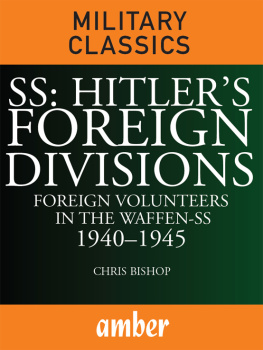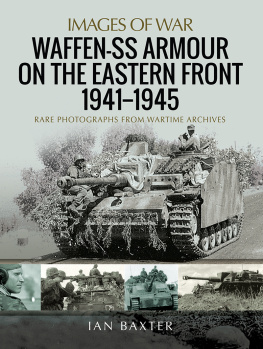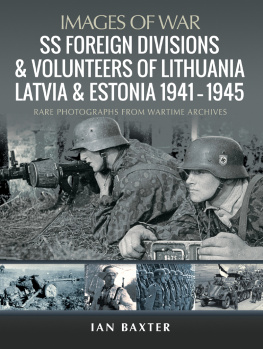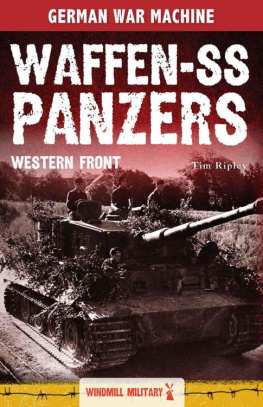INTRODUCTION
Even today, more than six decades after the outbreak of World War II, it still seems incredible that thousands of men whose countries had been conquered by the Nazis should have volunteered for service with the SS. Hundreds of thousands more volunteered or were conscripted into the Wehrmacht , the Kriegsmarine and the Luftwaffe . Many had no choice in the matter, but a significant number were willing members of the German armed forces, and those who served with the SS were mostly volunteers. But why did the SS recruit them and, having done so, trust them in battle?
During the course of World War II, the Waffen-SS grew from an elite force of four regiments composed solely of Germans meeting Heinrich Himmlers exacting physical and racial standards, into a polyglot force of 900,000 men in 39 divisions, with over half of its troops foreign volunteers or conscripts. Even so, at its peak the Waffen-SS represented only one-tenth of the strength of the Wehrmacht although it provided a quarter of German panzer strength.
Few people realize just how international were the German forces in World War II. It is estimated that nearly two million foreign nationals served under the Swastika. Although towards the end of the war many were transferred to the SS, large numbers served with the Army, particularly on the Eastern Front. The most committed of the foreign volunteers found a home in the SS, until parts of it were more like a German equivalent of the French Foreign Legion than the elite of the German race. Waffen-SS equipment and organization were the same as those of the Army. Units were interchangeable with Army units, and senior Waffen-SS officers adopted Army ranks.
Th e Waffen-SS
Although the SS did not welcome non-German volunteers until midway through the conflict in Russia, the idea of recruiting such men dated back to before the war. In his quest for a pan-Germanic Europe, Reichsfhrer-SS Heinrich Himmler had decreed in 1938 that non-Germans of suitable Nordic origin could enlist in the Allgemeine-SS . At that point in time the distinction between the civilian general SS, or Allgemeine-SS , and the armed SS, or Waffen-SS , did not exist. By the outbreak of war in 1939, however, the armed SS had emerged in its own right, as a separate entity from the Allgemeine-SS and from the Totenkopf units which guarded the concentration camps. The Waffen-SS played a small but important part in Germanys early campaigns. Its fighting reputation pleased Himmler greatly, and he wanted to increase the organizations importance. Established primarily as a security force, it would have to become much bigger if it was to play its part in the pan-Germanic future which would come after the war was won. But expansion did not come easily.
The explosive wartime growth of the Waffen-SS reflected Himmlers desire to create an instrument of political power that would safeguard the National Socialist revolution inside Germany. In the process, it would provide a counterweight to the influence of the Army. Although a number of former SS officers claimed after the war that the Waffen-SS was a purely fighting force, in truth the organization was never completely free of its political origins. As late as 1943, the preface to an SS panzer training manual contained a paragraph which read: ... The SS fulfils a requirement to provide an unflinching force at the disposal of the leadership of the Reich in any situation. This includes the maintenance of order at home by the use of any and all methods.
The main stumbling-block to this expansion was the Army. With good reason, the generals had feared the establishment of a powerful party organization answerable only to Hitler. Before the war, the General Staff had blocked SS acquisition of artillery, and had forbidden the formation of an SS field division. Above all, the Army controlled the number of men the SS could recruit. Each year, the Oberkommando der Wehrmacht (OKW), or Military High Command, laid down the proportion of men to be conscripted to each arm or service. All men of recruitable age were registered with the local Wehrbezirkskommando (WBK), or Military District Headquarters. No volunteer could join a military unit until he had been released by his local WBK, and the Army made sure that as few men as possible were released to join the SS.
Conditions for the SS improved slightly with the outbreak of war. In spite of the rigorous selection process, German volunteers were plentiful. Many were attracted to Himmlers romantic dream of a race of blue-eyed, blond heroes, an elite formed according to laws of selection based on criteria of physiognomy, mental and physical tests, character and spirit. His aristocratic concept would combine charismatic authority with bureaucratic discipline. The SS man would represent a new human type warrior, administrator, scholar and leader, all in one whose messianic mission was to repopulate Europe. The SS played on its status as an elite force by using its Nazi connections to recruit the cream of the Hitler Youth movement and the Reichsarbeitsdienst (RAD), or Reich Labour Service, before they could be snatched up by the Wehrmacht .
Himmlers plans received a major boost when an energetic Swabian SS-Brigadefhrer named Gottlob Berger was given responsibility for SS recruitment. With recruitment blocked by the Army, it was Berger who suggested to Himmler that he should make use of his control of the concentration camp guards and the police to form two new formations, the Totenkopf and the Polizei Divisions. As the SS expanded, these were eventually to become the 3rd SS-Panzer Division Totenkopf and the 4th SS-Panzergrenadier Division SS-Polizei .
Volunteers were still coming in, but early public approval of the Waffen-SS was beginning to diminish, and the armed SS began to acquire some of the sinister reputation of other branches of the organization. Heinz Hhne, in his seminal work The Order of the Deaths Head , quoted a Sicherheitsdienst (SD the SS Security Service) report written in March 1942:
... it may be stated that by its achievements the Waffen-SS has won its place in the popular esteem. Particular reference is made to the good comradeship and excellent relations between officers, NCOs and men ... Unfortunately voices are also to be heard saying that the Waffen-SS possesses no trained officers and that therefore SS men are recklessly sacrificed ... Critical voices are to be heard saying that the Waffen-SS is a sort of military watchdog. SS men are trained to be brutal and ruthless, apparently so that they can be used against other German formations if necessary ... The Waffen-SS is a most ruthless force.








